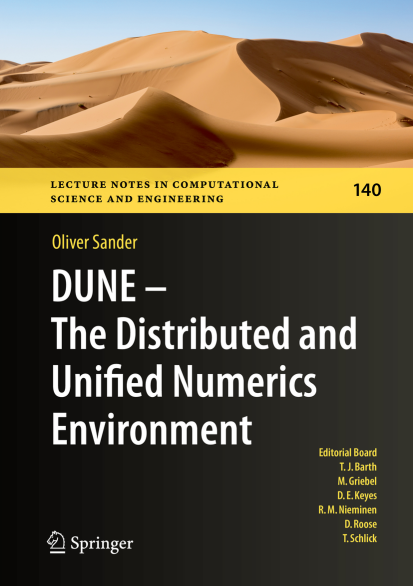Getting started
You want to install and use Dune on your machine and you are a complete novice? Then this is the right place to start!
We will guide you through the installation process, and show you a first example program.
Installing Dune
It is important to note that installation of Dune requires a computer system with a relatively recent operating system, either Linux or Apple MacOS. Windows is not officially supported, but installation can be done via virtualization, see installation on Windows. There are a number of different ways how to install and use Dune on your computer (click on the links to follow the instructions):
Dune C++ binary packages
This is the most convenient way to get started if you do not want to modify the Dune sources.
The details depend on the system you are using:
Python packages via PyPI
Installation of Dune from the Python Package Index (PyPi). This is another very convenient way to install Dune which does not require root access and works on a broad range of systems including MacOS for which binary packages might not be available.
Full installation from source
Sooner or later you will most likely want to use the latest Dune features or even add new features to the Dune code modules. This will require you to build Dune from source.
Running a first example
Your first example with C++
Assume you have installed the Dune core modules. A simple example to test your installation is to create a structured grid and print some information. Therefore, first create your own Dune project with the command
duneproject my-first-example dune-grid 0.1 my-first-example@dune-project.org
from within a directory where your Dune installation can be found (either the installed modules are in
subdirectories or installed in the system).
This will create a directory my-first-example for a Dune module with dependencies dune-grid. Put
the following code into the file my-first-example/src/my-first-example.cc:
#include <iostream>
#include <dune/common/parallel/mpihelper.hh>
#include <dune/grid/yaspgrid.hh>
#include <dune/grid/io/file/printgrid.hh>
int main(int argc, char* argv[]) {
auto& env = Dune::MPIHelper::instance(argc, argv); // initialize the environment
Dune::YaspGrid<2> grid({1.0,1.0}, {10,10}); // structured grid [0,1]x[0,1]
std::cout << grid.size(0) << std::endl; // print nr of elements
Dune::printGrid(grid, env, "my_yaspgrid"); // print grid as png (requires `gnuplot`)
}
The code can be compiled and run with dunecontrol. From the folder containing the directory
my-first-example run the command
dunecontrol --module=my-first-example all
and execute my-first-example/build-cmake/src/my-first-example.
You can find a more detailed description of these first steps with some background in the first chapter of Oliver Sander’s Dune book. It describes installation from binary packages, installation from the source repository, how to create your own Dune module, and also how to solve a simple PDE with the Dune core modules.
Your first example with Python
You can test the installation
by constructing a simple structured grid. Call python and then execute
from dune.grid import structuredGrid
grid = structuredGrid([0,0],[1,1],[10,10])
print( grid.size(0) ) # should return 100
grid.plot() # requires the installation of `matplotlib`
For a more detailed description of the Python bindings take a look at the section on the DUNE grid interface as part of the dune-fem tutorial.
Working with further Dune modules
dune-pdelab
Instructions for installing from the source. and using the tutorials.
Recordings of the virtual DUNE/PDELab course 2021 are available for self-study. The material can be found here.
dune-fem
Detailed instructions on how to install dune-fem and its Python bindings using pip..
 |
Legal Statements / Impressum |
Hosted by TU Dresden & Uni Heidelberg |
generated with Hugo v0.111.3
(Nov 1, 23:33, 2025)
|
Legal Statements / Impressum |
Hosted by TU Dresden & Uni Heidelberg |
generated with Hugo v0.111.3
(Nov 1, 23:33, 2025)Content
More info
… can be be found in the Dune book by Oliver Sander.

The chapter on How to get started with the C++ code can be read online.
Videos on different aspects of DUNE are available online.